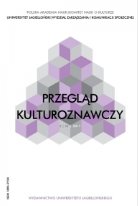TEXTUAL CAVES: EXPANDING THE LITERARY WRITING SPACE
TEXTUAL CAVES: EXPANDING THE LITERARY WRITING SPACE
Author(s): Piotr MareckiSubject(s): Social Sciences, Language and Literature Studies, Poetry, Theory of Literature, ICT Information and Communications Technologies
Published by: Wydawnictwo Uniwersytetu Jagiellońskiego
Keywords: writing space; remediation; cave writing; textual caves; concrete poetry; visual text; spatial humanities; digital humanities;
Summary/Abstract: Marecki discusses three textual caves created by Polish concrete poets: Stanisław Dróżdż’s Między (1977); Małgorzata Dawidek Gryglicka’s Krótka historia przypadku (1997); and Dróżdż’s Żyłki (2002). The medium of all three works was a white cubicle placed in a gallery. Each piece played with the corporeality of the viewer and their experience of networked space, expanding the concept of writing space in literature. Między is an original work of international importance, whereas the two later caves are re-mediations, recycled variations of the original subject. The true innovation of Między is the idea to place text in a space beyond the page, picture or gallery wall. Dróżdż’s break with tradition created a networked piece; the body of the viewer is physically inscribed on the work when he or she enters it. Dawidek’s installation, created two decades later, has been called a hypertext in space. Therein, the artist incorporated new physical solutions, including links to the lexias, which were written by hand and glued to the walls. Dawidek thus nuanced the use of corporeality in her work, which was designed for a particular space (the viewer moves through the book by following physical links; for instance, when the text mentions exiting, the viewer actually follows a link towards the door). Finally, Dróżdż’s 2002 work Żyłki constitutes another step forward. In a similar manner to Dawidek, the artist used physical links. By placing the work in the space that was occupied by Między back in 1977, he thus recycled his initial medium. Marecki utilizes tools for describing the nature of the writing space developed by thinkers like J.D. Bolter and applies Zenon Fajfer’s concept of “Liberatura” to develop a media-specific analysis of these three textual caves, as well as the intertextual relations between them.
Journal: Przegląd Kulturoznawczy
- Issue Year: 33/2017
- Issue No: 3
- Page Range: 334-349
- Page Count: 16
- Language: English

